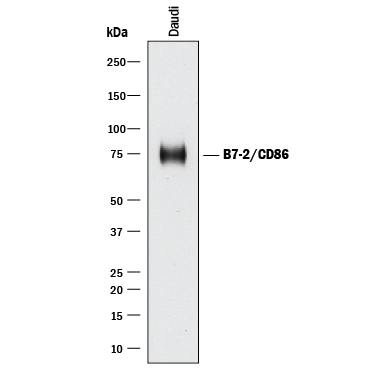Human B7-2/CD86 Antibody
R&D Systems, part of Bio-Techne | Catalog # MAB141


Key Product Details
Validated by
Species Reactivity
Validated:
Cited:
Applications
Validated:
Cited:
Label
Antibody Source
Product Specifications
Immunogen
Ala23-His244
Accession # P42081
Specificity
Clonality
Host
Isotype
Endotoxin Level
Scientific Data Images for Human B7-2/CD86 Antibody
Detection of Human B7‑2/CD86 by Western Blot.
Western blot shows lysates of Daudi human Burkitt's lymphoma cell line. PVDF membrane was probed with 5 µg/mL of Mouse Anti-Human B7-2/CD86 Monoclonal Antibody (Catalog # MAB141) followed by HRP-conjugated Anti-Mouse IgG Secondary Antibody (Catalog # HAF018). A specific band was detected for B7-2/CD86 at approximately 75 kDa (as indicated). This experiment was conducted under reducing conditions and using Immunoblot Buffer Group 1.Detection of B7‑2/CD86 in Human Blood Monocytes by Flow Cytometry.
Human peripheral blood monocytes were stained with Mouse Anti-Human CD14 PE-conjugated Monoclonal Antibody (Catalog # FAB3832P) and either (A) Mouse Anti-Human B7-2/CD86 Monoclonal Antibody (Catalog # MAB141) or (B) Mouse IgG1Isotype Control (Catalog # MAB002) followed by Allophycocyanin-conjugated Anti-Mouse IgG Secondary Antibody (Catalog # F0101B).Detection of B7-2/CD86 in Human Ramos Cell Line by Flow Cytometry.
Human Ramos lymphoma cell line was stained with Mouse Anti-Human B7 Formatting the figure legends (adjusted HTML for better line wrapping). Only applies to the website insert. 2/CD86 Monoclonal Antibody (Catalog # MAB141, filled histogram) or isotype control antibody (Catalog # MAB002, open histogram) followed by PE-conjugated Goat Anti-Mouse IgG secondary antibody (Catalog # F0102B). View our protocol for Staining Membrane-associated Proteins.Applications for Human B7-2/CD86 Antibody
CyTOF-ready
Flow Cytometry
Sample: Human whole blood monocytes and Ramos lymphoma cell line
Knockout Validated
Western Blot
Sample: Daudi human Burkitt's lymphoma cell line
Neutralization
Formulation, Preparation, and Storage
Purification
Reconstitution
Formulation
Shipping
Stability & Storage
- 12 months from date of receipt, -20 to -70 °C as supplied.
- 1 month, 2 to 8 °C under sterile conditions after reconstitution.
- 6 months, -20 to -70 °C under sterile conditions after reconstitution.
Background: B7-2/CD86
B7-1 and B7-2, together with their receptors CD28 and CTLA-4, constitute one of the dominant costimulatory pathways that regulate T- and B-cell responses. Although both CTLA-4 and CD28 can bind to the same ligands, CTLA-4 binds to B7-1 and B7-2 with a 20‑100 fold higher affinity than CD28 and is involved in the down‑regulation of the immune response. B7-1 is expressed on activated B cells, activated T cells, and macrophages. B7-2 is constitutively expressed on interdigitating dendritic cells, Langerhans cells, peripheral blood dendritic cells, memory B cells, and germinal center B cells. Additionally, B7-2 is expressed at low levels on monocytes and can be up-regulated through interferon gamma. B7-1 and B7-2 are both members of the immunoglobulin superfamily. Human B7-2 is a 329 amino acid (aa) protein containing a putative 23 aa signal peptide, a 224 aa extracellular domain, a 21 aa transmembrane domain, and a 61 aa cytoplasmic domain. Human B7-2 and B7-1 share 26% amino acid identity. Human and mouse B7-2 share 50% amino acid identity. However, it has been observed that both human and mouse B7‑1 and B7‑2 can bind to either human or mouse CD28 and CTLA-4, suggesting that there are conserved amino acids which form the B7-1/B7-2/CD28/CTLA-4 critical binding sites.
References
- Azuma, M. et al. (1993) Nature 366:76.
- Freeman, G.J. et al. (1993) Science 262:909.
- Freeman, G. et al. (1991) J. Exp. Med. 174:625.
- Selvakumar, A. et al. (1993) Immunogenetics 38:292.
- Chen, C. et al. (1994) J. Immunol. 152:4929.
- Freeman, G.J. et al. (1993) J. Exp. Med. 178:2185.
Alternate Names
Gene Symbol
UniProt
Additional B7-2/CD86 Products
Product Documents for Human B7-2/CD86 Antibody
Product Specific Notices for Human B7-2/CD86 Antibody
For research use only




